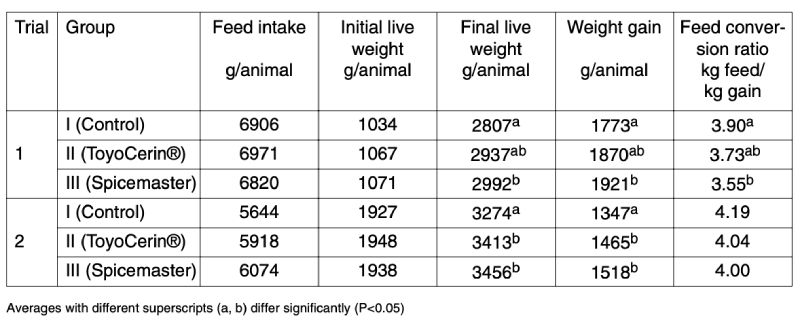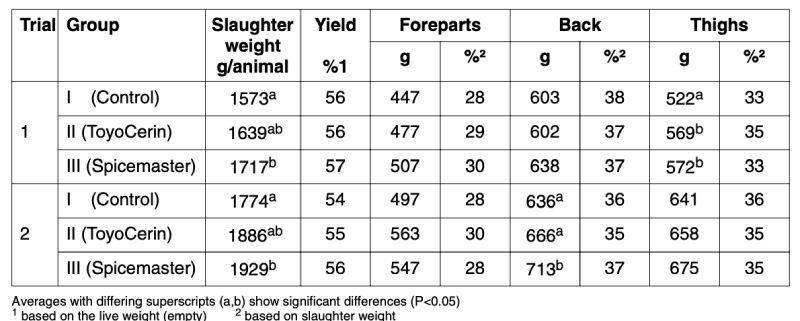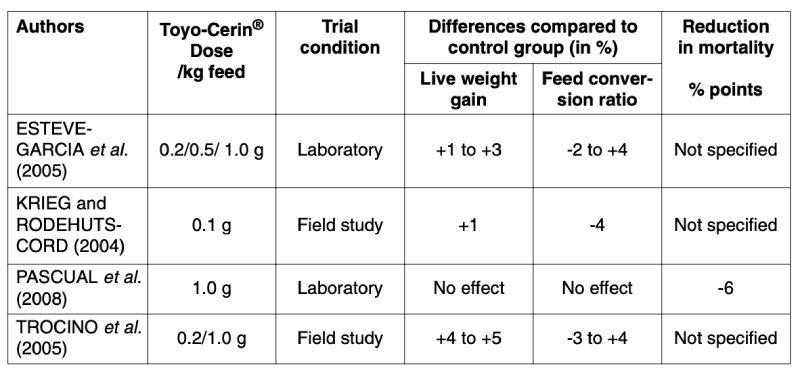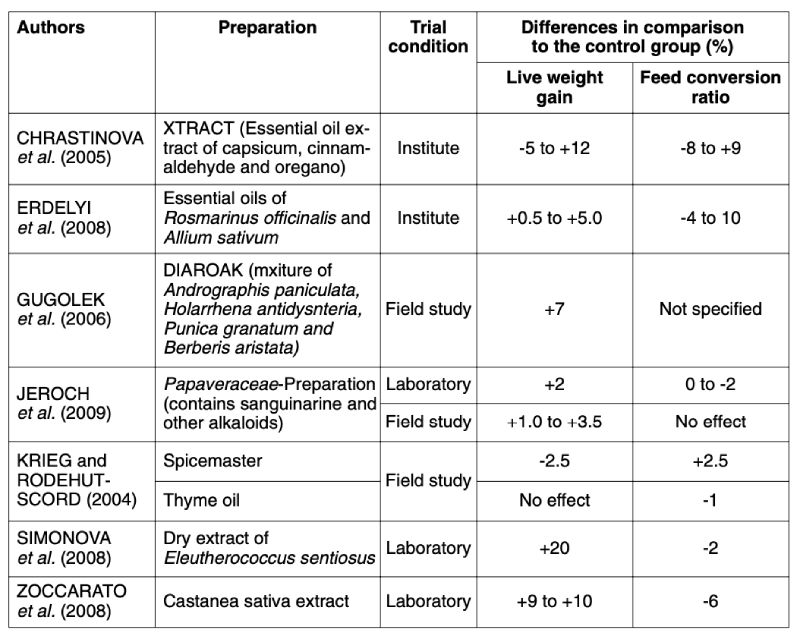Summary
In 2 performance trials, each consisting of 3 groups of New Zealand white rabbits, the effects of the
probiotic product ToyoCerin® (spores of B. cereus var. toyoi) and the phytobiotic product Cuxarom
Spicemaster (brown algae mixed with the herbs and spices basil, fennel, garlic and cinnamon and
essential oils of aniseed and thyme) were tested on the fattening performance and carcass characteristics of the animals. Each group comprised 9 (trial 1) or 11 (trial 2) animals, respectively, kept in
single cages. In the 56-day trials (commencing after weaning at 30 days in trial 1 and at 8 weeks
in trial 2) the growth of the animals and the feed conversion ratio improved considerably as a result
of the two additives tested in comparison to the control groups. The additives also had a positive
effect on the weight of the carcass and the parts thereof. However, not all effects of the preparations
tested are statistically significant.
Key words
rabbits, probiotics, phytobiotics, growth, feed conversion ratio, carcass composition
Introduction
Until the final ban on antibiotic feed additives in the EU which took effect on 01.01.2006 (EU regulation
no. 1831/2003) these feed additives were also added to rabbit feed. Amongst other things they were
used to reduce the occurrence of diarrhoea following weaning which is a major cause of losses in
commercial rabbit production (TETENS, 2007). As alternatives for antibiotic feed additives FALCAOE-CUNHA et al. (2007) and others discuss probiotics, prebiotics, enzymes as well as organic acids and
critically evaluate the literature available concerning growing rabbits. On various occasions phytogenic
preparations (phytobiotics, botanicals) are also named as possible alternative substances (e.g. WENK,
2005).
In comparison to pigs and poultry far less scientific publications are available concerning possible
alternatives for use in rabbits (FALCAO E-CUNHA et al., 2007). In order to evaluate these substances
as supplements in rabbit feed, further trials are urgently needed, as FALCAO E-CUNHA et al. (2007)
conclude from their literature review. Therefore trials were carried out with the probiotic preparation
ToyoCerin® and the phytobiotic preparation Cuxarom Spicemaster.
The results are presented below
and compared with similar data found in the literature.
Own trials
Materials and methods
Using the preparations ToyoCerin® and Cuxarom Spicemaster 2 trials (1, 2) were carried out in
succession, each trial consisting of 3 groups:
- Group I: commercial feed for rabbits with no supplements (control group)
- Group II: commercial feed as group I plus 100 mg ToyoCerin®/kg feed,
- Group III: commercial feed as group I plus 300 mg Cuxarom Spicemaster/kg feed.
In trial 1 each group consisted of 9 animals, while 11 animals were allocated to each group in trial 2.
The trial duration was 56 days for each trial.
Both trials were carried out using New Zealand white rabbits. In trial 1 young rabbits reproduced at
the Institute and weaned at the age of 30 days were used. For trial 2 the animals were acquired
from a commercial rabbit farm. At the beginning of the trial they were 8 weeks old and thus had a higher
body weight in comparison to trial 1.
The probiotic preparation ToyoCerin® contains spores of Bacillus cereus var.toyoi at a concentration
of 1×1010 cfu/g. The phytogenic feed additive Cuxarom Spicemaster is a mixture of brown algae,
several herbs and spices (basil, fennel, garlic, cinnamon) and essential oils (aniseed, thyme). The
dosage of both trial preparations per kg feed was in accordance with the recommendations of the
contract partner Lohmann Animal Health, Cuxhaven, Germany.
The feed mixtures were manufactured in the compound feed plant UAB “Krekenavos pasawai”,
Krekenava/Lithuania. The mineral feed for the feed mixtures for the 3 groups (control / with ToyoCerin®
/ with Cuxarom Spicemaster) were produced by Basu-Mineralfutter GmbH in Bad Sulza/Germany.
The composition of the feed was the same for all 3 groups in both trials. It consisted of the following
components (per kg mixture): 174.0 g ground barley, 135.7 g ground oats, 90.0 g wheat bran, 165.0
g sunflower seed meal, 80.0 g soybean meal, 50.0 g dried sugar beet pulp. 260.0 g dried grass
meal, 25.3 g mineral compounds, 20.0 g mineral feed (minerals, trace elements, vitamins, tested
additives (groups II and III)). The following nutrients and energy contents in the mixtures (per kg with
88% dry matter) were calculated (MAERTENS et al., 2002): 170 g crude protein, 24 g crude fat, 126
g crude fiber, 329 g neutral detergent fibre, 156 g starch, 49 g sugar, 9.93 MJ digestible energy.
The trials were carried out in the vivarium of the Lithuanian Veterinary Academy, Kaunas, i.e. under
laboratory conditions. The animals were kept in single cages of a two-deck battery.
The trial room was
partly air-conditioned. The rabbits were offered the feed in pellet form (4 mm diameter) via automatic
feeders ad libitum. Water in drinking-water quality was permanently available via nipple drinkers.
The following data were collected:
- Health status (diarrhoea incidence etc.), losses and possible causes,
- Individual live body weight at the beginning and at the end of each trial,
- Individual feed intake by weighing the amount of feed offered at the beginning of the trial and the
amount left at the end of the trial,
- Carcass characteristics of all rabbits of trials 1 and 2 at the end of the trial (DLG-Scheme;
PETERSEN, 2004),
- Meat quality parameters for the back and the legs of all carcasses (trial 1).
The feed conversion ratio (kg feed per kg weight gain) was calculated from feed intake and live weight
gain. The program STATISTIKA for WINDOWS (STATSOFT, INC., 2007) was used for the statistical
evaluation of the trial results.
Results
No problems occurred in either trial. No signs of diarrhoea were determined in any of the animals. No
losses occurred which is most likely due to the ideal housing conditions.
The data on fattening performance are shown in table 1. In trial 1 the animals of all 3 groups ate
virtually the same amount of feed. In contrast to this, the two feed additives in trial 2 caused a higher
intake of feed (by 5% group II, Toyocerin® respectively 7.5% group III, Cuxarom Spicemaster), which,
however, is not statistically significant due to the considerable variance between animals in the same
group.
In both trials the probiotic and phytobiotic feed additives improved the growth of the animals,
whereby the effect of Cuxarom Spicemaster (phytobiotic) was even stronger than that of Toyocerin®
(probiotic).
Table 1: Feed intake, live weight gain and feed conversion ratio during the trialS

In trial 2 the effects of the feed additives were even more evident than in trial 1, although the animals
were older at the beginning of the trial. The feed conversion ratio was reduced by both feed additives.
With this parameter also, the phytogenic preparation demonstrated higher efficacy than the probiotic,
and the reduction in the feed conversion ratio was slightly higher in trial 1 in comparison to trial 2. On
the whole, however, the differences in this parameter between the control group (I) and trial groups
(II, III) are not statistically significant.
The carcass weight as well as the weight of the valuable carcass parts increased as a result of both
feed additives analogously to the increase in live weight at the end of the trial (see table 2). However,
the differences in comparison to the control group are only significant in part. In contrast to this, the
slaughter yield (%) and the percentage in carcass composition changed only slightly.

The additives tested had no influence on the chemical composition of the back and thigh meat.
Discussion
In both trials ToyoCerin® improved growth and feed conversion ratio, although the results were only
significant in part. As no digestive disorders could be determined and no losses occurred, it is not
possible to make any statements on the influence of
ToyoCerin® on the health status of the animals.
Other experiments on young rabbits have been carried out over the last few years with the same
probiotic preparation. The information on the influence on growth, feed conversion ratio and mortality
is shown in table 3. The results obtained differ substantially, ranging from no effect to an improvement
in performance similar to that achieved in our experiments. Only one study reports a considerable
decrease in the mortality rate (PASCUAL et al., 2008).
KRIEG and RODEHUTSCORD (2004) found
no influence of ToyoCerin® on the level of animal losses nor on the share of animals showing symptoms of diarrhoea; they observed, however, that the average duration of the diarrhoea was clearly
reduced. In a literature study by
FALCAO-E-CUNHA et al. (2007) including a total of 20 experiments
with various probiotic preparations, positive effects of probiotics on live weight gain, feed conversion
ratio and mortality are predominant, but the effects differ substantially (weight gain increased by 1-
13%, feed conversion ratio improved by 1-17%, and mortality was reduced by 2-17 percentage
points).
In both trials the phytobiotic preparation Cuxarom Spicemaster considerably improved growth and
feed conversion ratio, with the efficacy being slightly superior to the probiotic product ToyoCerin®
which was tested at the same time. Only KRIEG and RODEHUTSCORD (2004) also tested this feed
additive on rabbits (table 4); there was no positive effect on weight gain and feed conversion ratio
(the differences in comparison to the control group were insignificant). Thyme oil, a component of
Table 3: Results reported in the literature with the probiotic ToyoCerin® on growing rabbits

Cuxarom Spicemaster (table 4), also demonstrated virtually no influence on the named parameters.
However, both additives had a positive effect on the health status of the animals (fewer days with
diarrhoea, less animal losses as a result of E.coli).
The trial results with further phytobiotic preparations (see table 4) vary significantly. The summary
table shows results reaching from considerable effects to insignificant or no improvement in performance
and even negative effects.
GUGOLEK et al. (2006) report a considerable reduction in losses (from
13% to 7%) after supplementing the fattening feed with the phytogenic preparation DIAROAK (a
mixture of Andrographis paniculata, Holarrhena antidysnteria, Punica granatum and Berberis aristata).
In all other studies shown in table 4 – with the exception of the article by KRIEG and RODEHUTSCORD
(2004) – no indication of improved health status of the animals after supplementing the feed with
herbal preparations can be found.
The positive effects of both substances tested can also be observed from the slaughtering data. A
comparison with the data in the literature, however, is not possible as virtually no appropriate data
were collected at the end of the growth trials. Only
JEROCH et al. (2009) report on numerically
increased slaughter and carcass part weights as a result of the herbal feed additive Sangrovit®.
Conclusions
Both preparations showed positive effects under laboratory conditions. The results obtained for the
probiotic preparation „ToyoCerin®“ again confirm that probiotics can be used as a feed additive in
growing rabbits as an alternative to feed antibiotics. In order to give a final evaluation on the phytogenic product “Cuxarom Spicemaster” further trials are needed, particularly trials carried out under
field conditions.
Laboratory trials generally do not provide any information on the effects on the health
status of the animals.
Table 4: Results published with phytobiotic substances in growing rabbits

CHRASTINOVA, Lubica., CHRENKOKA, Maria, RAFAY, J., ONDRUSKA, L., SOMMER, A. (2005): Plant feed supplements
in rabbits nutrition. Tagungsband 4. BOKU-Symposium, 27. Oktober in Wien, 164-167.
ERDELYI, M., MATIC, ZS., GERENCSER, ZS., PRINCZ, Z., SZENDRÖ,ZS., MEZES, M. (2008): Study of the effect of
rosemary (Rosmarinus officinalis) and garlic (Allium sativum) essential oils on the performance of rabbit. Proc. 9th World
Rabbit Congress, June 10-13, 2008, Verona-Italy, 649-653.
FALCAO-E-CUNHA, L., CASTRO-SOLLA. L., MAERTENS, L., MAROUNEK, M., PINHEIRO, V., FREIRE, J., MOURAO, J.L.
(2007): Alternatives to antibiotic growth promoters in rabbit feeding: a review. World Rabbit Sci. 15, 127-140.
ESTEVE-GARCIA, E., RAFEL, O., JIMENEZ, G. (2005): Eficacia de Toyocerin® en Conejos de engorde. Proc. XXX
Symposium de Cuincultura de Asescu, Villadolid, 85-89.
GUGOLEK, A., LIPINSKI, K., HARTMAN, Areta, KLEWSKA, Anna (2006): Effects of a herbal additive on the production
results of New Zealand White rabbits. Pol. J. Natural Sciences, Suppl. No 3/2006, 615-620.
JEROCH, H., KOZLOWSKI, K., LIPINSKI, K., JEROCH, Jolanta., ZDUNCZYK, Z., JANKOWSKI, J. (2009): Wirkung des
phytogenen Papaveraceae-Präparates Sangrovit® bei wachsenden monogastrischen Nutztieren. Züchtungskunde 81(4),
279-293
KRIEG, R., RODEHUTSCORD, M. (2004): Kaninchen: Einsatz ausgewählter Futterzusatzstoffe. DGS-Magazin, Woche
14, 51-54.
MAERTENS, L., PEREZ, J.M., VILLAMIDE, M., CERVERA, C., GIDENNE, T., XICCATO, C. (2002): Nutritive value of raw
materials for rabbits: ERGAN tables 2002. World Rabbit Science 10 (4), 157-166.
PETERSEN, J. (2004): Handbuch zur Kaninchenfleischgewinnung. Verlag Oertel & Spörer Reutlingen.
PASCUAL, J.J., MOYA, V.J., MARTINEZ, E., CALVO, M.A-, ADELANTADO, C., JEMINEZ, G., BLANCH, A., CASTILLO,
M. (2008): Effects of dietary inclusion of toyocerin® (Bacillus cereus var. toyoi) on performance, health and faecal nitrogen
excretion in growing rabbits. Proc. 9th World Rabbit Congress, June 10-13, 2008, Verona-Italy, 781-785.
SIMONOVA, M., SZABOVA, R., CHRASTINOVA, L., LENKOVA, A., HAVIAROVA, M., STROPFOVA, V., PLACHA, I., FAIX,
S., VASILKOVA, Z., MOITO, J., RAFAY, J. (2008): The use of ginseng extract in rabbits. Proc. 9th World Rabbit Congress,
June 10-13, 2008, Verona-Italy, 809-813.
STATSOFT INC., 2007: Statistica (data analysis software system), version 8. www.statsoft.com.
TETENS, Martina (2007): Intensive Kaninchenhaltung in Deutschland. Dissertation Tierärztliche Hochschule Hannover.
TROCINO, A., XICCATO, G., CARRARO, L., JIMENEZ, G. (2005): Effect of diet supplementation with toyocerin® (Bacillus
cereus var. toyoi) on performance and health of growing rabbits. World Rabbit Sci. 13, 15-26.
WENK, C. (2005): Einsatz von Kräutern und deren Extrakten in der Tierernährung: Erwartungen und Möglichkeiten.
Tagungsband 4. Boku-Symposium Tierernährung, 27. Oktober 2005 in Wien, 17-27.
ZOCCARATO, I., GASCO, L., SCHIAVONE, A., GUO, K., BARGE, P., ROTOLO, L., SAVARINO, G., MASOERO, G. (2008):
Effect of extract of chestnut wood inclusion (ENC®) in normal and low protein aminoacid supplemented diets on heavy
broiler rabbits. . Proc. 9th World Rabbit Congress, June 10-13, 2008, Verona-Italy, 873-877.
Zusammenfassung
In 2 Leistungsversuchen mit jeweils 3 Gruppen Mastkaninchen der Rasse Weiße Neuseeländer
wurde die Wirksamkeit des probiotischen Präparates „ToyoCerin®“ (Sporen von B. cereus var. toyoi)
und des phytobiotischen Präparates „Cuxarom Spicemaster“ (Mischung aus einer Braunalge mit den
Kräutern Basilikum, Fenchel, Knoblauch und Zimt sowie den ätherischen Ölen von Anis und Thymian)
auf Mastleistung und Schlachtkörpermerkmale geprüft. Jede Gruppe bestand aus 9 (Versuch 1)
bzw. 11 Tieren (Versuch 2) in Einzelkäfighaltung. In den 56 Tage dauernden Versuchen (Beginn
nach dem Absetzen mit 30 Tagen im Versuch 1 und mit 8 Wochen im Versuch 2) wurden im Vergleich
zur Kontrollgruppe das Wachstum der Tiere und der Futteraufwand durch beide geprüften Zusätze
verbessert. Auf die Gewichte der Schlachtkörper und deren Teilstücke hatten die Zusätze gleichfalls
einen positiven Effekt. Nicht alle leistungsverbessernden Wirkungen der Prüfpräparate sind jedoch
signifikant.
 Linkedin
Linkedin




